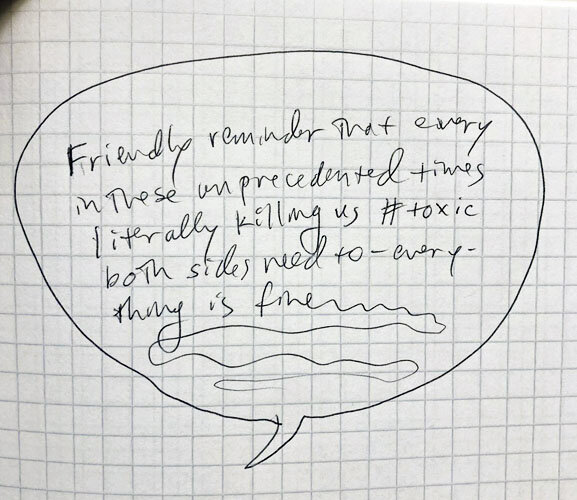Sound & Silence in the COVID Age
As I start this blog post, I can hear the whirr and thump of the dishwasher. I can hear my dogs snoring beneath my chair. I can hear air traffic overhead. It’s a quiet day.
And yet for all that, can I even hear my own thoughts?
This blog has been really silent lately. Trust me, Gentle Reader, I regret that fact very much. It’s certainly not that I haven’t been reading-- my To-Read list is actually down from 52 to 15 (thank you, Los Angeles Public Library!). There’s plenty of topics in the news and culture that I could weigh in on. But maybe there’s the rub. I feel somewhat compelled to only pick words that can meet this moment. Only Utterances of True Genius will suffice.
So what do I say?
I repeat comforting platitudes. My Facebook posts burst with bland, banal cheer, or else memories of happier days. I message friends-- I feel like I could turn into a parrot, with how often I type “Thinking about you! Hope you’re okay! Squawk! Heart emoji!” (More or less.) I’m sending out query letters regularly-- that’s a worthy use of my voice, to be sure.
And what am I not saying?
I don’t share a lot of political opinions-- I don’t want to start a fight I cannot win. (That is, if I win a fight but lose a friend, I haven’t won at all.) I don’t talk about my pervasive terror of climate change. There are whole reams of feelings that I keep hidden, even from myself if at all possible.
And there are friends of mine who have suffered devastating losses-- whose houses ring with silence. I want to help them, desperately, but what can I possibly say?
In the age of COVID, I feel like my words are never enough. And as a writer, that’s a painful spot to find oneself in.
When historians look back on 2020 and later years, they may well define this era by silence and sound. There is the reprehensible silence of the previous administration, which refused to acknowledge the danger of the coronavirus until it was too late, and refused to adopt a unified, federal response. There was no mourning for the thousands upon thousands of deaths-- a deafening lack.
But there are other kinds of silence. There is the silence of listening to all sides, and of deep consideration. I think the new administration does a better job in that regard. A bully can easily slam their fist and force their opinion through, but it takes maturity to really listen. Americans aren’t typically famous for listening, but hey, this is an unprecedented era.
I also wonder if future historians will see the chatter of our moment as some kind of psychological tell. The Disney megacorporation never allows their streaming service to rest quiet. As soon as the Mandalorian wrapped up, it was on to Wandavision, and then breathlessly on to Falcon and the Winter Soldier. Next, next, next! We must have chatter on, always, (Bridgerton! Snyder Cut! Tiger King!) and it must be entertaining but never really shake up what we know. If we like it, we’ll watch it again and again. Anything to drive out the silence where our economy and our friends used to be.
But maybe I’m being cynical. Maybe that sound n’fury is what the Information Age was always destined to become. Or perhaps this is all a flash in the pan, and this is the most homogenized our culture will get. Only future historians will know.
Very likely they’ll be confused, too.
In honor of the notion of silence and sound, I’ve been reflecting on a couple of books which may interest you, Gentle Reader (I admit, I’m not immune to Bridgerton’s charms).
I recently reread Speak: The Graphic Novel, a faithful adaptation of Laurie Halse Anderson’s classic, illustrated by Emily Carroll, whose art takes an already-powerful story to a new level. It tells the story of Melinda, a freshman girl hated by her peers because she busted the end-of-summer party-- but why, exactly, no one cares to know. Even Melinda would rather not know. The book is about isolation, finding one’s voice after suffering the unspeakable-- also about growth, scarring, and art.
A Thousand Questions by Saadia Faruqi is, on its surface, about the culture clash between American and Pakistan, seen through the eyes of two ten year old girls: Mimi, an American visiting her grandparents in Karachi for the first time, and Sakina, who works in Mimi’s grandparents’ kitchen. But it’s also about discovery and friendship, about T-shirts with hokey jokes on them, about trying new food and dreaming big-- and the limits of dreams. And, of course, questions.
Even though this blog post is silent except for the clacking of keys (and, earlier, the swoosh of a ballpoint pen), I’d like to say, thank you for listening. I’ll try to get better at saying what’s on my mind and in my heart— and I hope you, Gentle Reader, will take good care of yourself until we meet again.
Stay safe!
